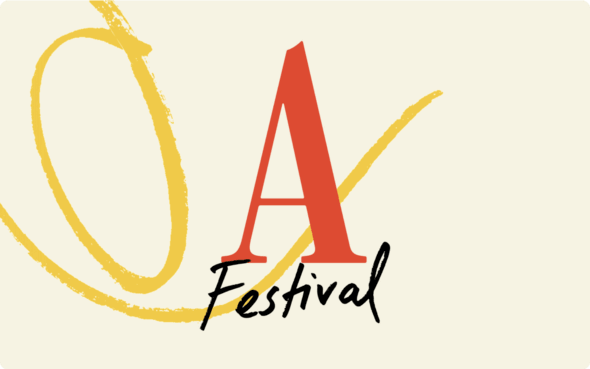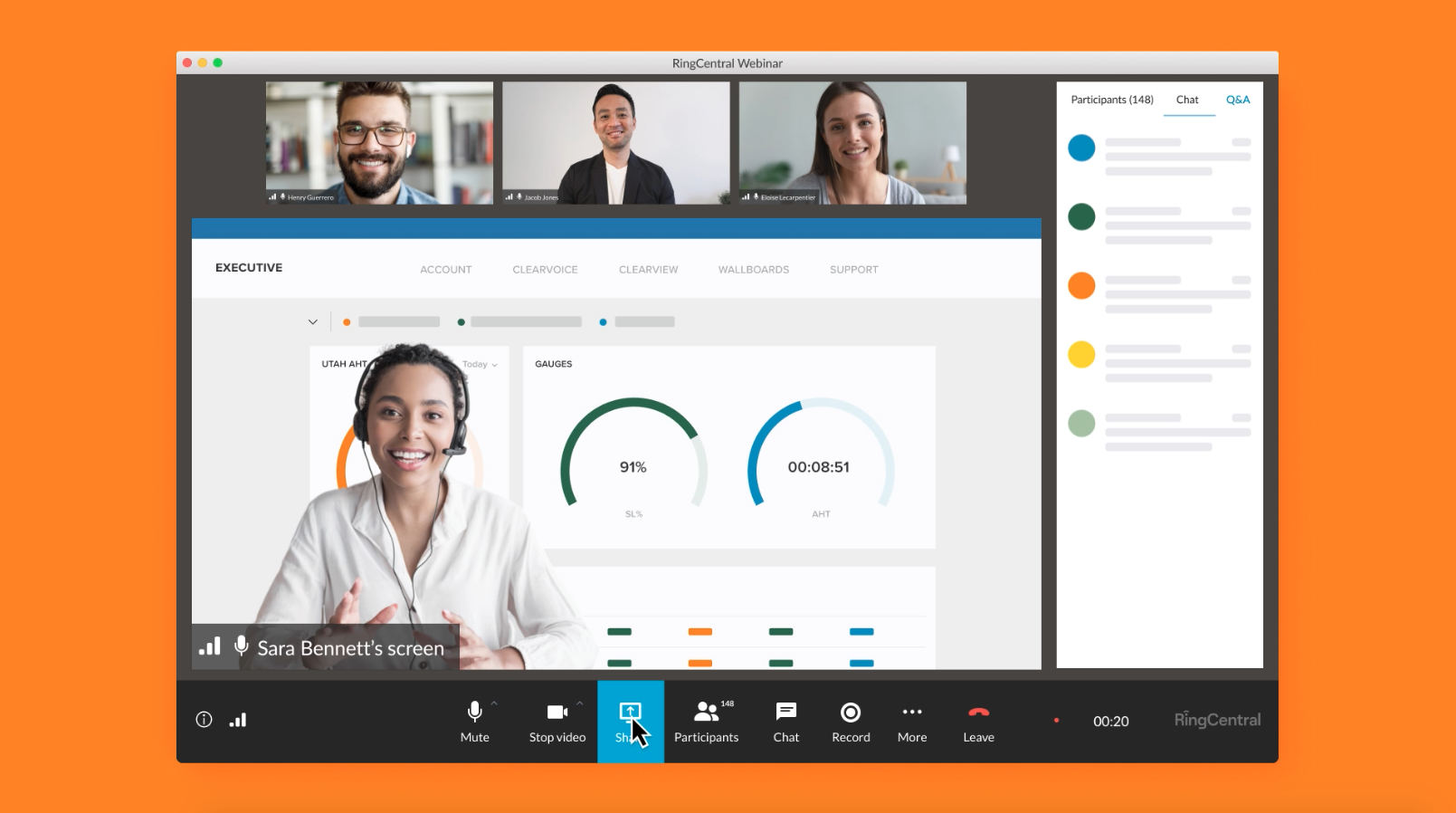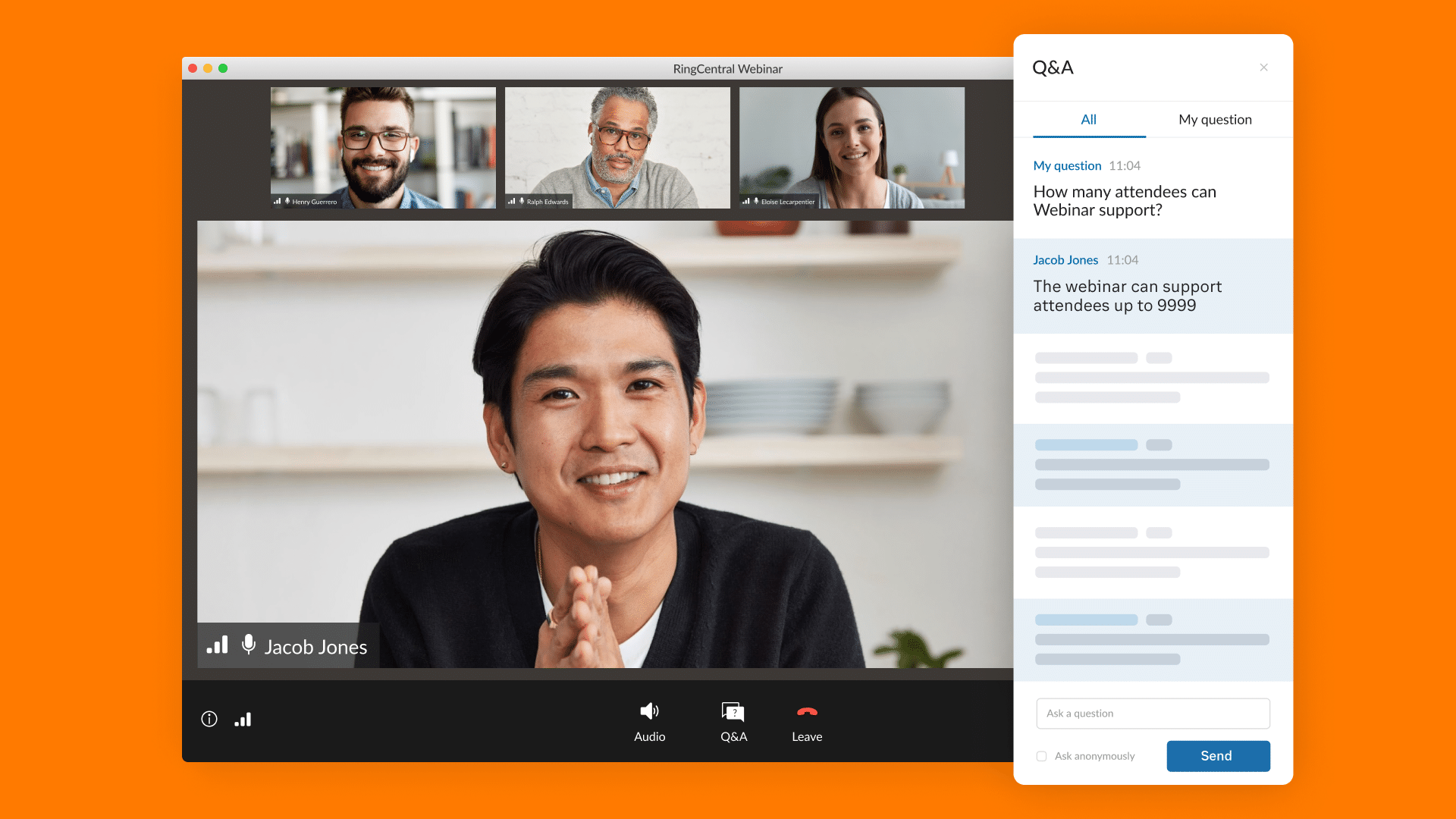Hopin is now RingCentral Events.
Nearly half of event professionals claim engagement is the biggest contributor to their success and their greatest challenge. This begs the question: Do we really understand how to engage an audience?
We may know engagement when we see it.
It’s that book you can’t put down.
That all-night conversation with a person you can’t get enough of.
That teacher whose class you actually want to attend.
That three-hour movie that left you barely blinking. (Or better yet, that 10-episode Netflix show you devoured with the determination only someone who’s truly engaged can muster.)
When you get right down to it, it’s like we’re spending our lives peering around the corner, looking for that next thing — that person, that content, that moment — that will make us feel truly engaged.
So why can’t we get people to engage with an hour-long webinar in the same way? With the same dedicated attention span? With the same feverish fervor?
The simple answer is we’ve been led to believe authentic engagement can be easily hacked when (spoiler alert) it can’t.
Just as an immersive movie-watching experience comes only after a bevy of Hollywood professionals have worked their magic on scripts, costumes, and cinematography, a deeply engaging event requires expertise and engineering.
In this guide, we’ll explore how to build engaging experiences today — but first, we’ll look back at how engagement has evolved over time.
In this guide:
What the hell is engagement, anyway?
How ‘engagement’ lost all meaning
The new standards of engagement
What the hell is engagement, anyway?
Merriam-Webster defines engagement as “emotional involvement or commitment” and “the state of being in gear.”
For a deeper dive, we turned to engagement consultant Scott Gould. Scott is the author of “The Shape of Engagement” and has been building shared experiences since he was 16.
“There’s you, and there’s me,” Scott explains. “As long as we remain separate and unaware of each other, we’re unengaged. Imagine a Venn diagram with a circle of you and a circle of me. If those circles overlap, we’re now engaged. The sense of ‘we’ transcends you and me –– that’s engagement. It’s essentially togetherness.”
At the end of the day, engagement is a relationship. And while that definition might sound fairly simple, as any event organizer will tell you, it’s the process of engaging people that’s the real challenge.
After all, engineering engagement, particularly at events or meetings, is rarely a happy accident. It’s a layered and often loaded topic.
The many layers of engagement
Professionals across a potpourri of industries have long been trying to better understand engagement and how to do it right –– particularly in our complex, tech-laden world where there’s no shortage of experiences, people, and content crying out for you to engage with them. (More on this in a minute.)
The bottom line is there aren’t any shortcuts because engagement is more than skin deep.
Scott has a three-part framework for understanding the different psychological states of engagement:
- Head engagement: Also known as cognitive engagement, this is when someone is mentally together with you. Think communication, like a conversation between two people.
- Hands engagement: Also known as behavioral engagement, this is when someone is physically engaged with you. Think action, like people playing a team sport or solving a puzzle as a group.
- Heart engagement: Also known as affective engagement, this is when someone feels a sense of bonding and inclusion. Think integration, like being engaged with a political party, religion, or brand.
If people come together in any or all of these states, they’re engaged.
Take the concept of a coffee date where all three forms of engagement are on display:
- The invitation to have coffee is the communication, or head engagement
- Actually going to have the coffee is the physical action, or hands engagement
- The feeling you have after the coffee date (provided it went well) is the forming of an emotional bond between you and the other person, or heart engagement
But wait, there are also different types of engagement. Things like:
- Employee engagement: Are you aligned with your work, company, and colleagues?
- Customer or brand engagement: Mac or Android? Tesla or Audi?
- Community engagement: What causes do you stand for? What would you fight for? What would you die for?
- User engagement: What apps or other tech solutions do you use regularly?
The list goes on.
Finally, there are varying scopes of engagement. If you think of engagement as a fractal –– layer upon layer protruding off into oblivion –– you start to see how engagement can stretch and change shape, particularly when it comes to events.
For example, there’s broad engagement with all your events (your brand, event strategy, or an event series) all the way down to micro-engagements you set up during an experience (like signage to direct people to the toilets).
“It begins to get really confusing really quickly,” Scott says. “That’s why I understand when somebody who’s running an event says, ‘We need more engagement,’ and you think, ‘Well, what on Earth do we mean by that? More ticket sales? More participation in our polls? More raving fans?’”
So, how did everything get so complicated and confusing? Well, a lot has changed over time.
How ‘engagement’ lost all meaning
We throw around the word engagement like it’s just another item on our never-ending to-do lists. As a result, it’s taken its place alongside other hall-of-fame digital marketing buzzwords like ‘clickbait’ and ‘gamification.’
But in processing the idea of engagement as a relationship and the result of coming together, we come to realize it’s been around as long as humans (and even animals) have existed. Where there were beings with the capacity to come together, there has been engagement.
So, how did it go from basic instinct to meaningless buzzword?
Well, for one, the barriers to entry didn’t used to be nearly as plentiful. Remember, there was a time when even the radio didn’t exist. (You thought we were going to say flip phone, didn’t you?)
Society used to revolve around oral and then written communication. Storytellers would play important roles, verbally passing down cultural traditions and knowledge. Imagine sitting in a hall or around a fire as an elder told you about your personal family history and what shaped your community over time. You’d likely be hanging on every word.
Then, we invented written language, which democratized the power of the story. Anyone with education and access to resources — first ink and paper, then a printing press –– could tell a story. New voices emerged, but engagement was no longer a given. After all, with more content came more competition for attention.
Still, in large part, people gathered with others within a few miles of their homes. Or, they read the stories in their local newspaper. And that was that.
But the world leaned hard into a one-to-many model of mass communication with the invention of the radio, which was quickly followed by motion pictures and television.
Research published in 1949 called “Experiments on Mass Communication” looked at films the U.S. Army was using to train and inspire soldiers. The authors of the study found that while soldiers learned from the films, the media wasn’t engaging them on an emotional level. But when the researchers added a participatory element, viewers reported learning more and being more engaged.
By the 1950s, broadcast producers and advertising executives realized that to stand out in the new sea of audio and video content, they had to craft emotional hooks — and get their audience actively involved.
In other words, head engagement alone was no longer enough; professional marketers had to lean into hands and heart engagement now, too.
How many-to-many communication changed the engagement game
Fast forward to 2024. We’ve supplemented one-to-many mass communication models, like newspapers, radio shows, and TV programs. Centralized voices communicating carefully crafted messages now compete with anyone and everyone spilling their guts on TikTok.
Today’s many-to-many communication model –– playing out across social media feeds, live streaming platforms, online forums, the metaverse, and beyond –– has left us inundated with opportunities to consume content. And facing a challenging landscape for deep engagement.
Consider the fact that 30,000 hours of new YouTube content is uploaded every hour. More than 388,000,000 tweets have been sent today alone.
People are forced to be picky when it comes to what they’ll glance at –– nevermind what they’ll give undivided attention to. Attention is a zero-sum game: When you’re deeply engaged with one thing, by definition, you’re disengaged with many others.
Today’s quest for deep engagement
Despite our now-endless ocean of opportunities to connect and engage, meaningful, authentic engagement still often eludes us.
Take influencer Tinx who has popularized a new way of rating movies and TV shows. She gives them a 1-10 “phone scale score,” representing how much time she spent looking at her phone versus focusing on the content in front of her. A score of one means she was barely on her phone at all, but the far-more-popular seven or eight means she was on her device more than she was watching the big screen.
Engineering meaningful engagement –– in a world now drenched in tech, complexity, innovation, and globalization –– is hard. Yet, it’s perhaps more important than ever to achieve.
Social neuroscientist Matthew Lieberman explored the human desire for closeness in his book “Social: Why Our Brains Are Wired to Connect,” noting that, as humans, our brains are “wired for reaching out to and interacting with others.”
He argues that in schools where students have high engagement and a strong sense of belonging, grades are better. And in communities where there are strong social ties — strong heart engagement — people live longer and experience less pain.
If we extrapolate from that argument, it turns out deep engagement can be the difference between success and failure –– or even life and death.
So, the stakes are high. But facilitating authentic engagement often seems out of reach today –– it’s that thing we’re all desperately trying to design for, bottle up, and measure. We now put it on a pedestal and hold it up as the holy grail of modern shared experiences.
So, how do we demystify the process of engaging people, cut through the clutter, and design experiences that result in attendees saying, “I feel seen, I feel heard?” By meeting today’s new standards.
The new standards of engagement
Given the way engagement has evolved, shared experience professionals are now required to graduate from Engagement 101 and take it to the next level.
So, what are the new standards we have to hit to engineer a genuinely engaging experience in 2024? Read on to wrap your mind around the seven golden rules in today’s engagement playbook.
1. Mix it up.
As we’ve learned, engagement is a many splendored (and layered) thing. There are no shortcuts to doing it right.
With that in mind, don’t just focus on one type of engagement. You have to think holistically and build programs that balance the three states of engagement. According to Scott, the best events fulfill all three states:
- Head engagement: The content and communication is highly compelling. People learn something they can apply. There’s a message and it’s a story you want to be part of. The event brand means something.
- Hands engagement: There are ways to be actively involved and for attendees to create something they’ll actually use. They can participate and their questions get answered.
- Heart engagement: There are ways to connect and bond with other people. The experience means something and the organizers build on that feeling so when the event comes around again, people are desperate to get involved.
TED is known for striking this balance. They typically offer highly compelling presentations, workshops, and space to chat and share meals. “In particular, they excel at head engagement. They recognize people are happy to sit and listen when you’ve got world-class speakers on stage,” Scott says.
The bottom line? Sticking to participatory elements alone won’t cut it.
2. Focus on stand-out content.
Think about that 10-episode Netflix binge. You take no action aside from navigating to the show, hitting play, and tapping that “next episode” button before autoplay takes over. But you’re passively engaged with that show –– intensely so.
Why? Because the content itself is engaging. And the folks who produced that show put a lot of thought into how to make that content engaging. So much so that you might feel compelled to go talk about it on social media or write some fan fiction. See how active engagement can naturally stem from passive engagement and deepen the overall experience?
“Events could do well to be like living museums,” Scott says. “Living moments in time that give people space to reflect. There’s meaningful participation, but there’s also the ability to chill. And that means, as always, just good content.”
So, don’t settle for mediocre, because without great content –– including getting speakers who are going to deliver –– it’s nearly impossible to build a deeply engaging experience.
“We’re doing a lot of participatory Hail Mary,” Scott says. “If people aren’t already engaged attentively, they’re going to be less engaged with participation.”
In fact, according to Scott, passive engagement is as much –– if not more –– a part of overall engagement as active, participatory moments. And if you’re not designing for passive engagement, you’re likely ignoring a large group of people who are happy to attend events and just watch. Consider, for example, all the people who read social media posts without liking or commenting on them.
“Participation is often done tokenistically,” Scott adds. “And we do it because we’re desperate to show that people are participating: ‘We’re now going to do a poll! Oh look, we can see everyone’s joining in! Everyone is really engaged!’ It has some utility but it’s actually very shallow; it’s a click.”
3. Hire the right people.
According to Scott, the great events of today feature three types of people:
- People who engage the head: Speakers who are theatrical and well polished. They capture your mind and you’re engrossed. You might not remember exactly what they said, but you remember thinking, ‘WOW.’
- People who engage the hands: People who are downright great at making things –– people who can command a workshop. They’re experts in creating the end product they’re putting together and they know how to help other people make that end product.
- People who engage the heart: These are the social butterflies –– the party people whose job it is to help others mingle and connect. They help drive the narrative at your event. Your cup never runs dry at their house and when the experience is over, everyone says, ‘They made this a great time for me.’
People are at the heart of every experience, so don’t just think of them as functional. Pick people who are at the top of their game and excellent at their craft.
“When we’re booking event hosts, we generally book a comedian,” Scott notes. “It’s essentially saying the person we have to glue all this together doesn’t actually know about the content. They’re just a little bit funny. It makes no sense. The message is: ‘This content is so dry we need a comedian to be the butter.’ Get someone who knows the content but also has the charisma to hold an audience. They’re harder to find but they do exist.”
Have people in the mix who aren’t trained speakers but need to deliver during things like sales pitches or sponsor slots? Don’t give them a keynote –– instead, give them an interview conducted by that great host.
4. Don’t let things get stale.
Put on a show. Create a sense of theater. Stimulate the senses. Make it social. And leave a little something to the imagination.
For example, at his in-person events Scott places random objects around the room, stacks books as decorations, and puts odd things on stage. “They’re talking points,” he says. “People wonder: ‘Why is that there?’ They stoke curiosity. You don’t see this very often. You often arrive and you know what everything is for; there’s no mystery.”
So, what are those dry events –– the ones that push you to a seven or eight on influencer Tinx’s “phone scale score” –– typically missing? Scott says they don’t lead people into flow and they’ve lost their sense of dramatic arc.
“When you arrive –– in person or virtually –– there’s nothing there that suggests this is going to be exciting,” he adds. “Nothing to theatrically grab you. Instead, the organizers were thinking about transfer of knowledge, ticket sales, and promotion of the key sponsor.”
This is where having a strong event brand and theme can help. Find ways to make attendees participants in the story of the event, and if the event is part of a series, tie the experiences together into a cohesive, compelling story.
Consider the experience you get at any Disney theme park. All employees are considered cast members because they’re contributing to a broader story. Cast members are instructed never to utter the words, ‘I don’t know,’ but to instead come up with answers to questions that forward the magical story for park guests.
“We used to say, ‘you don’t preach people full, you preach them hungry,’” Scott says. “You give them enough so they’re desperate to want to come back.”
5. Make something useful.
Scott believes creative engagement will make or break events moving forward.
“Events should be a place where attendees make something that they can actually go on and use the following day,” he says. “And where you, as the event host, are remembered — because you were the facilitator of that making.”
He gives all his clients what he calls a “Monday-morning guarantee.”
“If you can’t use what I’ve discussed come Monday morning, you get your money back or I do it all again,” he says. “I want everything we do together to be Monday-morning usable.”
Organizers can check themselves with a few simple questions to attendees on post-event surveys:
- Did you learn what you were expecting to learn?
- Did you get actionable insights you could apply right away?
And don’t forget to summarize what came out of each event. Capture the content and turn it into a collection of assets that lasts so attendees can put the material to good use. After all, your event content is the gift that keeps on giving.
6. Give the people what they want.
Listening to your audience and actively responding to their needs is non-negotiable in 2024.
Take, for example, the Oscars. According to The New York Times, the Academy of Motion Picture Arts and Sciences made changes to the telecast in an effort to boost viewership and engagement, which have been waning in recent history. In a bid to stay relevant, the Oscars switched things up by:
- Cutting the announcement of several categories from the live show
- Including three hosts, after several years with no host
- Adding in two fan-favorite category awards
But as it turned out, those changes were largely for naught, as the show’s live viewership was its second-lowest ever. Now, on the flip side, this edition of the Oscars was the most popular in history on social media (you can probably guess why).
A simple hypothesis started circulating around why the live viewership tanked even post-facelift: None of the changes emerged from what viewers actually wanted.
Seek to fully understand what your audience is looking for and how they want to be engaged. Then, turn up the dial on those elements. Don’t assume you know best.
7. Don’t take a one-size-fits-all-formats approach.
In-person, virtual, and hybrid experiences each require a different approach, so a blanket engagement strategy isn’t likely to yield success.
Respect each event format by understanding how physical location and event setup influence how and why people engage. Then, tailor your engagement strategy and tactics and design an experience that will facilitate authentic engagement.
If someone is attending an in-person event, for example, they’re physically present, so distractions will be limited to some degree. They’ve committed to being there.
Translocationism, or the idea that people behave slightly differently than they normally would outside their typical location, is also at play.
“There are some expectations they’ll bring with them,” Scott says. “Plus, you can create motion. A little walk from here to there is great for clearing the brain. It’s also great for keeping the body active so you can learn for longer. It’s why in-person events can be a whole day but whole-day virtual events are agony.”
Festivals like SXSW and Mardi Gras tap into opportunities to create motion, feature changing locations, and stimulate the senses as forms of engagement. “Your ability to create theater is pronounced in person,” he adds.
On the other hand, when it comes to virtual experiences, you’ve traveled nowhere, distractions abound, psychological cues are limited, and there’s no physical motion to stimulate your body and brain. In many ways, it’s often harder to facilitate deep engagement.
With that in mind, to truly be engaging, online experiences typically demand:
- Incredible speakers and highly animated talks to fill the small screen: Think props and slides featuring strong visuals and motion. “If someone’s dry on stage, they’re even drier virtually,” Scott notes. “And people are going to take the nap in their bed.”
- Strong facilitators: People who can see a dozen faces on a screen and have the ability to pick individuals out quickly.
- Half-day events and movement breaks: Avoid scheduling a full-day digital experience unless you’re hosting something attendees can jump in and out of periodically.
Participatory elements and co-creation sessions can also present big opportunities in the virtual world.
“People have their tools right there –– email, files, work documents, props, Miro,” Scott says. “They’re also likely feeling safe in their home. So they’re probably willing to do some things they might not do if they were in a group of people physically. I try to make the making even more specific in virtual settings, which is counterintuitive because we try to nudge it down a bit thinking it won’t be as effective.”
Then, there’s hybrid. According to Scott, there are two core engagement considerations for this format:
- Letting go of the obsession around getting the two audiences to connect with each other and instead just creating the most engaging experiences for the various audiences.
- Trying to solve for FOMO. “You will miss out on some things, but you’ll get to be in on others,” he says. “I think we need to just accept that and instead ask ourselves: ‘Where do we want to be?’”
Whether you have everyone in the room where it happened or the comfort of their own homes, meeting your audience where they are will help you determine how to engage them in meaningful ways.
The new tools of engagement
The right event technology can support every state and type of engagement –– from head to hands to heart, and from active to passive.
Being able to customize each experience for different groups of attendees allows you to truly listen to what your audience wants and needs, then exceed engagement expectations.
And in-depth data and reporting capabilities can help you get granular when measuring engagement, so you’re not presenting stakeholders with a fuzzy story of, “We got more engagement.” Instead, you can point them to performance metrics along key indicators.
Don’t get caught on the back foot without technology to support the engaging experiences you want to create. And don’t leave engagement up to chance.
Let the right event technology help you build events and experiences that meet today’s engagement standards.
Contact RingCentral Events today to ensure meaningful engagement is part of all your experiences.
Originally published Sep 01, 2022, updated Oct 20, 2024





